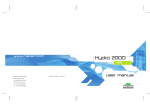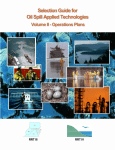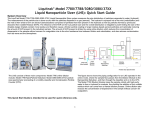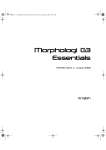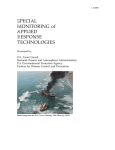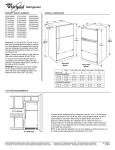Download System Manual
Transcript
Commercial Reverse Osmosis System Manual Tethys 200P & 300P Models Standard Features 2.5” Thin Film Composite (TFC) HF3 Ultra Low Pressure Membrane 2.5” Champ™ PVC Membrane Housing Aquatec 8800 Booster Pump with 110/220 VAC Transformer 5 Micron Sediment Prefilter Carbon Block Cartridge 1 Micron Sediment Prefilter Wall Mount Bracket for Space and Cost Savings, Easy Service, and Installation Solenoid Valve Regulates Water High Pressure Switch Auto-Flush Flow Restrictor Pump Pressure Gauge Models Design Gallons Per Day NaCl Rejection Recycle Line Recovery Element Size (in) Number of Elements Feed-Product-Waste Pump Hertz Voltage (VAC) Dimensions W x L x H (in) Weight (lbs.) Tethys 200 Tethys 300 Wall Mount Wall Mount 200 GPD 300 GPD 98% 98% No No 25% - 35% 25% - 35% 2514 HF3 2521 HF3 1 1 ¼”-¼”-¼” ⅜”-⅜”-⅜” Single 8800 Booster Pump Dual 8800 Booster Pump 50/60 50/60 110/220 110/220 7”x21.5”x31” 7”x28”x33” 45 lbs. 50 lbs. * Do not use with water that is microbiologically unsafe or of unknown quality without adequate disinfection before or after the system. † Membrane approximate initial capacity based on properly pretreated feed water of 2,000 PPM TDS as NaCl, 77°F, Silt Density Index below 5, and 60 psi applied pressure supplying water to atmosphere. Productivity will vary depending on the feed water conditions. Operating Parameters Maximum Temperature Minimum Feed Rate Minimum Feed Pressure Maximum Operating Pressure Maximum TDS Maximum Hardness Maximum Turbidity pH Range Maximum Chlorine Tolerance Maximum SDI 113°F (45°C) .3 GPM @ 60 psi 60 psi 150 psi 1000 ppm 5 Grains 1 NTU 4-11 0 ppm 5 General Information Your commercial reverse osmosis (RO) system is a durable piece of equipment, which with proper care, will last for many years. This user’s manual outlines operating and maintenance details vital to the sustained performance of your system. The test results included with your system indicate the performance of the system before it was shipped from the manufacturer’s facility. The systems are tested for permeate and rejection based on the following testing conditions: 77°F (25°C), 550 mg/L feed concentration, and 60 psi feed pressure. The systems is designed to run at approximately 150 psi operating pressure. Recoveries for your system can vary between 25 35%, depending on your application. NOTE: IN ORDER TO MAINTAIN THE SYSTEM’S WARRANTY, AN OPERATING LOG MUST BE MAINTAINED. Manual Overview This user’s manual has been prepared, in order to provide the operator of the system with information on start-up, operation, installation, maintenance, and troubleshooting procedures. Please feel free to contact your distributor or dealer with any additional questions that are not addressed in this user’s manual. Safety Summary Safety for the system operator and other personnel should always remain the highest priority. This user’s manual does not contain all necessary safety statements needed when operating the reverse osmosis system. Additional safety statements are included within the user’s manual text and are enhanced and defined as follows: NOTE: INDICATES STATEMENTS THAT PROVIDE FURTHER INFORMATION AND CLARIFICATION. CAUTION: INDICATES STATEMENTS THAT ARE USED TO IDENTIFY CONDITIONS OR PRACTICES THAT COULD RESULT IN EQUIPMENT OR OTHER PROPERTY DAMAGE. WARNING: INDCIATES STATEMENTS THAT ARE USED TO IDENTIFY CONDITIONS OR PRACTICES THAT COULD RESULT IN INJURY OR LOSS OF LIFE. Read This Manual Prior to operating or servicing the reverse osmosis system, this user’s manual must be read and understood fully. Keep it and other associated information for future reference and for new operators or qualified personnel near the reverse osmosis system. Startup Procedures 1. Inspect the system for any damage that could have occurred during shipment. Although our systems have been individually inspected, complete a quick inspection of the fittings, tubing, and other components. 2. Please provide a reasonable amount of space for installation and leave 6 inches of space below the filter housings for ease of maintenance. Note: The reverse osmosis system should be installed indoors and we suggest that it not be in direct sunlight or extreme cold. 3. Connect the 1/4” tube fitting to an incoming water source. The minimum water pressure should be at least 60 PSI. The system’s minimum operating pressure is 100 PSI, but the optimum operating pressure is 150 PSI. DO NOT OPERATE AT A PRESSURE EXCEEDING 160 PSI. The operating pressure can be increased on the face of the booster pump by turning the screw clockwise. 4. Plug the booster pump transformer into a power supply of 110 or 200 volts. 5. Connect the concentrate (waste) to the waste line or drain. 6. This system has been designed with an auto-flush restrictor. This restrictor automatically flushes the reverse osmosis system for 30 seconds every time it starts up. Note: The automatic pressure switch will shut the system off automatically, when the bladder tank is full. 7. Both sediment filters and carbon must be serviced regularly for optimal performance, the filters and water quality should be checked every 84 hours or twice a week. 8. Dispose of the product water until the conductivity of the product reaches your desired level. Use any conductivity meter to monitor the product water quality. A minimum quality of 96% NaCl rejection is recommended. Note: Any chlorine exposure will damage the membrane permanently. 9. This system has been factory wired and preset with a pressure switch at 40 psi, which is only to be used with a pressurized bladder tank. If using an open storage tank, a float switch will be required in order to regulate the system on and off. Maintenance Procedures 1. Periodically observe the quality and quantity of product water from the system. Note: Check the feed water pressure going into the reverse osmosis membrane, a significant drop in pressure could indicate a fouled up pre-filter. 2. If the TDS of product water increases to 25—30 PPM of NaCl, this will indicate bad NaCl rejection and the reverse osmosis membrane may need cleaning or to be replaced. 3. We suggest that you use a hand held TDS digital meter once per week to monitor the water quality. 4. If the TDS of the feed water exceeds 1000 PPM of NaCl, a larger flow restrictor should be used to extend the membranes life. 5. It is important to maintain and/or replace the carbon block regularly since the Thin Film Composite membranes are chlorine sensitive. Damage will occur with any chlorine present in the feed water. For additional information review our membrane specification sheets. 6. The product line should always have a one way valve “check valve” installed. The “check valve” should be checked regularly and replaced if not properly sealing. 7. Keep the feed water temperature above 4°C (36°F). Note: Extremely cold feed water will lower the product water output. Service Assistance If service assistance is required, please complete the following process: Call your local dealer or distributor. Prior to making the call, have the following information available: system installation date, serial number (found on left-hand side of front panel), daily log sheets, current operating parameters (e.g. flow, operating pressures, pH, etc.), and a detailed description of the problem. System Warranty/Guarantee The system’s manufacturer guarantees that the proposed product is to be free from any defects in material or workmanship when operated in accordance with written instructions for a period of one year (12 months) from start-up. Parts not manufactured by the system’s manufacturer are covered by their manufacturer's warranties which are normally for one year. Please contact your local dealer or distributor for information regarding these warranties. The manufacturer’s spiral wound membrane elements are guaranteed to operate within specifications when used for general water treatment for a period of 12 months from receipt providing that the membrane elements have not been abused by operating at high temperatures, high or low pH's, on un-disinfected water, or on solutions which tend to precipitate. For applications or water conditions other than those specified in the original purchase order for the reverse osmosis or ultra filtration system, the user should consult their local dealer or distributor for the suitability of the solution to be run in the membrane elements. Limitations on pH and temperature can vary with the membrane element type and the application of the equipment. For general water treatment, the pH should be kept between 5.5 and 10.0 with a temperature below 85°F (29°C) unless specifically designed for higher temperatures. If the system is being utilized for special applications or for pH or temperature ranges outside the stated limits, the warranty may be voided. A membrane element which fails to perform satisfactorily within the first 90 days after receipt, has not been mishandled, and is returned to the factory, will be replaced free of charge except for freight and local labor. If a membrane element fails to perform satisfactorily during the balance of the warranty period and with the return of the membrane element to the factory, the manufacturer will replace the membrane element with a new membrane element and will charge the user for the portion of the 12 months that the membrane element that was used plus incoming freight and local labor. Such pro rated charges will be based on the list price prevailing at the time of the warranty consideration. A new membrane element supplied under warranty terms will carry the standard 12 month new membrane element warranty. If a membrane element is to be returned for warranty inspection, the User must obtain a Return Good Authorization (RGA) number from your local dealer or distributor before returning the membrane elements. Membrane elements are to be returned freight prepaid to the manufacturer. The manufacturer will return any warranty replacement membrane elements to the customer prepaid. Membrane elements must be kept damp at all times and must be clean and bagged in a watertight bag before returning. Only the manufacturer’s approved cleaners, biocides, dispersants or other chemicals may be used with the membrane elements. Use of other chemicals may void the warranty. The user is responsible for knowing the membrane element material and for ensuring that chemicals harmful to the membrane element are never in contact with the membrane elements. It is the obligation of the user to maintain frequent operating data records. The manufacturer may request these records in the warranty evaluation. The user must notify its local dealer or distributor at the very first sign of changes in operation of the system or membrane elements. Such notifications should be in writing and should include all data requested on the operating log sheets.







